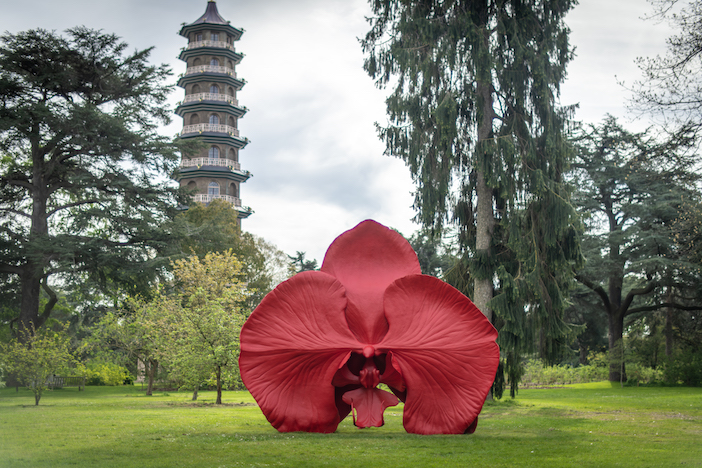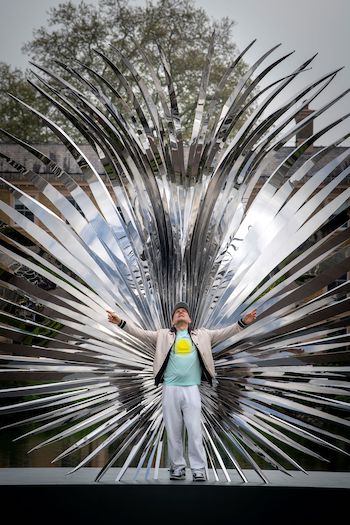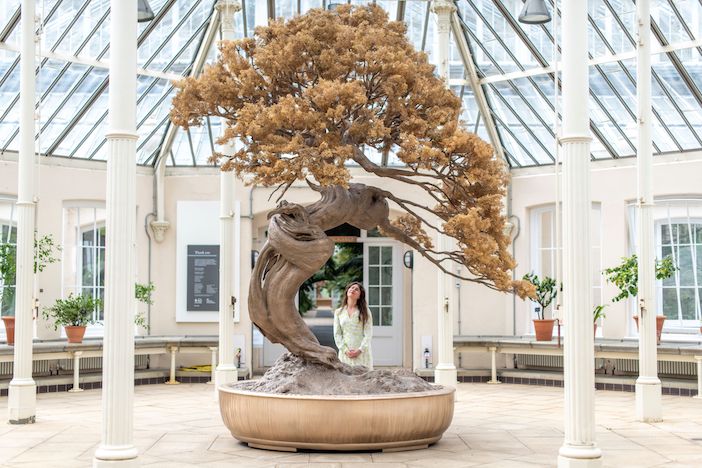“As humans we are not isolated from our environments; we interact and exist within them as a part of nature…” That’s contemporary artist Marc Quinn, introducing his latest show of work, on display at the Royal Botanic Gardens, Kew, in London. In this unique open space, the show combines scientific discovery, plant history and, right now, the freedom for visitors to encounter Quinn’s monumental sculptures in its grounds. Light into Life creates an interaction between people, landscape and seventeen remarkable sculptures, both in the grounds and inside the glasshouses, with an exhibition in the permanent art gallery.
As summer sets in this is the moment to respond to the artist’s display of work, ‘planted’ throughout the gardens, enjoyably disrupting each location. What makes the presentation so different is that Quinn has collaborated with Kew’s botanists and horticulturalists, to create specific sculptures that relate to this environment and the plants.

It is evident in the ‘Our Botanic Selves’ series of five sculptures, based on Kew’s herbarium specimens, which include drug discoveries, such as the opium poppy (Papaver Somniferum), used for pain relief in therapeutic treatments. Quinn has created representative works in this 2024 series in Opium Poppy, Happy Tree, Turmeric, Pacific Yew, and Himalayan May Apple. Each sculpture highlights how important plants and their healing properties are essential to human life, and each represents a plant that is used to treat a disease, including some types of cancer.
The sculptures and their placement within the gardens add to the pleasure of discovering them, while walking through the grounds. There is a good map given out, to guide visitors to find all the sculptures, including semi-hidden works within the trees and foliage, such as The Release of Oxygen, one of five sculptures based on orchids, all found in different locations. Four are made of stainless steel, while the fifth, Burning Desire, vast in size, was created in bronze and painted a fiery red. It sits close to the Great Pagoda, built in 1726, near the Temperate House and the Pavilion, to the west of the gardens’ landscape. It is stunning, as if made for this location.
 Quinn is fascinated by orchids, their beauty and rarity. And in a different series, three sculptures, made from stainless steel, are placed in front of the vast Palm House building, near to the gardens’ Victoria Gate entrance. Soaring over the Palm House pond is Event Horizon (Sabal), joined either side by Singularity (Bismarckia) and Singularity (Sabal), all created by Quinn this year. The giant fronds of shimmering metal are informed by the real palm tree species, Sabal and Bismarckia, located within the Palm House.
Quinn is fascinated by orchids, their beauty and rarity. And in a different series, three sculptures, made from stainless steel, are placed in front of the vast Palm House building, near to the gardens’ Victoria Gate entrance. Soaring over the Palm House pond is Event Horizon (Sabal), joined either side by Singularity (Bismarckia) and Singularity (Sabal), all created by Quinn this year. The giant fronds of shimmering metal are informed by the real palm tree species, Sabal and Bismarckia, located within the Palm House.
Marc Quinn gained public attention in the early ‘90s as one of the Young British Artists generation. His stand-out, most commented work was the frozen Head, from 1991, created from 10 pints of his own blood. He has updated this work every five years, like sculptural headshots of the artist through the decades. At Kew, the Shirley Sherwood Gallery of Botanical Art – the art gallery within its grounds – has Quinn’s Origin of the Species (1993), one of three frozen works. The others have been newly created for the exhibition. Human Nature is a calla lily bouquet created from frozen animal blood, a by-product of abattoir processing.
The floral frozen sculptures – using plants and flowers regularly on sale on petrol station forecourts and supermarkets – are mesmerising, taking flowers at their peak of freshness and plunging them into freezing silicone oil, to capture their intransient beauty at the moment of death. Quinn describes it as “the purest and most magical transformation of reality into art”. The gallery uses the room spaces to show Quinn’s remarkable drawings of plants and flowers. They are strikingly colourful, such as The White Mangrove of Isabela Island (2009).

Not to be missed, in the Temperate House Octagon, is Quinn’s series of Bonsai bronze sculptures, one of the major highlights of this show. Unmissable, due to its size, is the new work Held by Desire, The Dimensions of Freedom (Cloud Garden). This colossal bonsai is made of bronze and yet looks so delicate, like a living tree. It is informed by the work of the Japanese bonsai master Masahiko Kimura and placed at centre of the Octagon. In contrast to the popular size of controlled bonsai tree creations, which are pruned to maintain their diminutive size, Quinn imagines the bonsai tree set free to grow to its natural size again, given freedom from human intervention and containment. Surrounding this work are three other bonsai sculptures, dating from 2017-2023.
Kew Gardens is a lush open space, allowing visitors the freedom to wander through its beautiful landscape of trees and plantings and water spaces, and its historic glasshouses with rare specimen plants. Light Into Life is an added draw, complementing the gardens, and also features special talks and events, including a series of drawing workshops inspired by nature. If you have not been, a fabulous experience awaits you.
Marc Quinn: Light into Life at the Royal Botanic Gardens Kew until 29 September 2024. For more information, please visit Royal Botanic Gardens, Kew | Kew.




